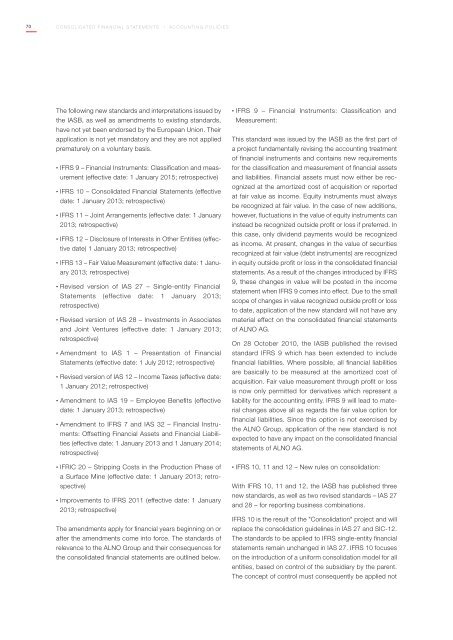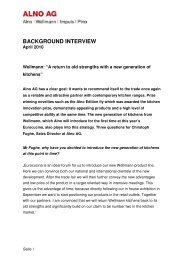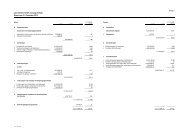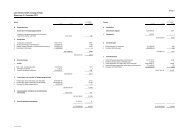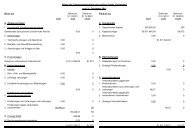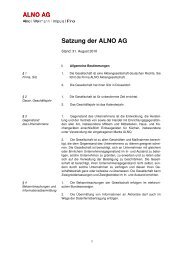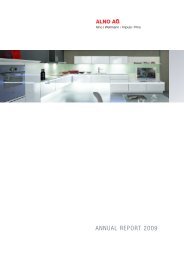70Consolidated financial statements | Accounting policiesThe following new standards and interpretations issued bythe IASB, as well as amendments to existing standards,have not yet been endorsed by the European Union. Theirapplication is not yet mandatory and they are not appliedprematurely on a voluntary basis.• IFRS 9 – Financial Instruments: Classification and measurement(effective date: 1 January 2015; retrospective)• IFRS 10 – Consolidated Financial Statements (effectivedate: 1 January 2013; retrospective)• IFRS 11 – Joint Arrangements (effective date: 1 January2013; retrospective)• IFRS 12 – Disclosure of Interests in Other Entities (effectivedate) 1 January 2013; retrospective)• IFRS 13 – Fair Value Measurement (effective date: 1 January2013; retrospective)• Revised version of IAS 27 – Single-entity FinancialStatements (effective date: 1 January 2013;retrospective)• Revised version of IAS 28 – Investments in Associatesand Joint Ventures (effective date: 1 January 2013;retrospective)• Amendment to IAS 1 – Presentation of FinancialStatements (effective date: 1 July 2012; retrospective)• Revised version of IAS 12 – Income Taxes (effective date:1 January 2012; retrospective)• Amendment to IAS 19 – Employee Benefits (effectivedate: 1 January 2013; retrospective)• Amendment to IFRS 7 and IAS 32 – Financial Instruments:Offsetting Financial Assets and Financial Liabilities(effective date: 1 January 2013 and 1 January 2014;retrospective)• IFRIC 20 – Stripping Costs in the Production Phase ofa Surface Mine (effective date: 1 January 2013; retrospective)• Improvements to IFRS <strong>2011</strong> (effective date: 1 January2013; retrospective)The amendments apply for financial years beginning on orafter the amendments come into force. The standards ofrelevance to the <strong>ALNO</strong> Group and their consequences forthe consolidated financial statements are outlined below.• IFRS 9 – Financial Instruments: Classification andMeasurement:This standard was issued by the IASB as the first part ofa project fundamentally revising the accounting treatmentof financial instruments and contains new requirementsfor the classification and measurement of financial assetsand liabilities. Financial assets must now either be recognizedat the amortized cost of acquisition or <strong>report</strong>edat fair value as income. Equity instruments must alwaysbe recognized at fair value. In the case of new additions,however, fluctuations in the value of equity instruments caninstead be recognized outside profit or loss if preferred. Inthis case, only dividend payments would be recognizedas income. At present, changes in the value of securitiesrecognized at fair value (debt instruments) are recognizedin equity outside profit or loss in the consolidated financialstatements. As a result of the changes introduced by IFRS9, these changes in value will be posted in the incomestatement when IFRS 9 comes into effect. Due to the smallscope of changes in value recognized outside profit or lossto date, application of the new standard will not have anymaterial effect on the consolidated financial statementsof <strong>ALNO</strong> AG.On 28 October 2010, the IASB published the revisedstandard IFRS 9 which has been extended to includefinancial liabilities. Where possible, all financial liabilitiesare basically to be measured at the amortized cost ofacquisition. Fair value measurement through profit or lossis now only permitted for derivatives which represent aliability for the accounting entity. IFRS 9 will lead to materialchanges above all as regards the fair value option forfinancial liabilities. Since this option is not exercised bythe <strong>ALNO</strong> Group, application of the new standard is notexpected to have any impact on the consolidated financialstatements of <strong>ALNO</strong> AG.• IFRS 10, 11 and 12 – New rules on consolidation:With IFRS 10, 11 and 12, the IASB has published threenew standards, as well as two revised standards – IAS 27and 28 – for <strong>report</strong>ing business combinations.IFRS 10 is the result of the "Consolidation" project and willreplace the consolidation guidelines in IAS 27 and SIC-12.The standards to be applied to IFRS single-entity financialstatements remain unchanged in IAS 27. IFRS 10 focuseson the introduction of a uniform consolidation model for allentities, based on control of the subsidiary by the parent.The concept of control must consequently be applied not
Consolidated financial statements | Accounting policies71only to parent-subsidiary relations based on voting rights,but also to parent-subsidiary relations based on other contractualagreements. The concept of control must thereforebe applied in future to special purpose entities which arecurrently consolidated according to the concept of risksand rewards.IFRS 11 was developed from the "Joint Ventures" projectand will replace IAS 31. Quota consolidation will be abolishedwhen IAS 31 becomes ineffective. Parallel changes interminology and classification must be taken into account,with the result that not all joint ventures which are currentlyincluded in the scope of quota consolidation need be<strong>report</strong>ed at equity in future. The equity method is applied inaccordance with the requirements of IAS 28 incorporatingsubsequent amendments.IFRS 12 combines the revised disclosure requirements ofIAS 27, IFRS 10, IAS 31, IFRS 11 and IAS 28 in a singlestandard,Whether the inclusion of special purpose entities will changeunder the new requirements is currently being investigated.The elimination of quota consolidation for joint ventures willhave no impact on the consolidated financial statements, asthe joint venture is already accounted for using the equitymethod.• IFRS 13 – Fair Value Measurement:The new standard rounds off the project to establish auniform, all-embracing standard for measurement. IFRS13 defines the procedure to be applied for measurementat fair value insofar as fair value measurement (or fair valuedisclosure) is stipulated by another IFRS. IFRS 13 does notspecify what is to be measured at fair value. According tothe new definition of fair value, fair value is characterized asbeing the selling price of an actual or hypothetical transactionbetween any two independent market-players understandard market conditions. The standard is almost allembracing,only IAS 17 and IFRS 2 are excluded. While thescope of these requirements remains almost unchanged forfinancial instruments, it is now defined more comprehensivelyand more precisely for other assets (e.g. investmentproperty, intangible assets, property, plant and equipment).Where financial instruments are concerned, the effect ofmarket and credit risks can now be included in the fair valueof a portfolio on balance, insofar as a relationship betweensuch effects can be proved. The familiar 3-stage fair valuehierarchy must be applied throughout. Two checks mustnow be performed for "declining market activities" (previously"inactive markets), namely (a) whether trade activitieshave declined and (b) whether subsequent transactionsactually undertaken were not in conformity with the market:a price deviating from the market price is only permitted ifboth are affirmed.Due to the small scope of financial assets recognized atfair value, we do not expect any material impact on theconsolidated financial statements.• Amendment to IAS 1 – Presentation of Financial Statements:This amended standard introduces new requirements asregards the presentation and development of other operatingresults. The individual elements making up the otheroperating result must consequently be classified accordingto whether or not they are subsequently reclassifiedin the income statement (so-called recycling process).Compliance with this requirement will result in changedpresentation of the statement of comprehensive incomein future. This will not have any impact on the financialposition and results of operations• Amendment to IAS 19 – Employee Benefits:The revised version of IAS 19 will completely replace theformer standard. The most important change concernsabolition of the corridor method. In future, all changes indefined benefit obligations and the fair value of plan assetsmust be recognized in full in the period in which they arise,with the result that pension provisions are now recognizedin the balance sheet in their full amount. Anothernew requirement concerns the presentation of changes indefined benefit obligations and plan assets in the incomestatement. The change in net liability must be subdividedinto three elements in future. Current service costs andnet interest cost must in future be <strong>report</strong>ed in the incomestatement under personnel expenses and financial resultrespectively. The third element, the so-called remeasurementcomponent, essentially comprises actuarial gainsand losses and must be recognized outside profit or lossunder other operating results. Recognition and measurementof employee termination payments will be affectedby changes to the accounting of termination payments,including a distinction between payments in return forservices rendered and payments in return for terminationof the employment relationship. Disclosure requirementsare also extended by IAS 19. Since actuarial gains andlosses are already recognized in equity, the new accountingrequirements will not have any material impact on thenet assets, financial position and results of operations ofthe <strong>ALNO</strong> Group. The changed accounting requirements


